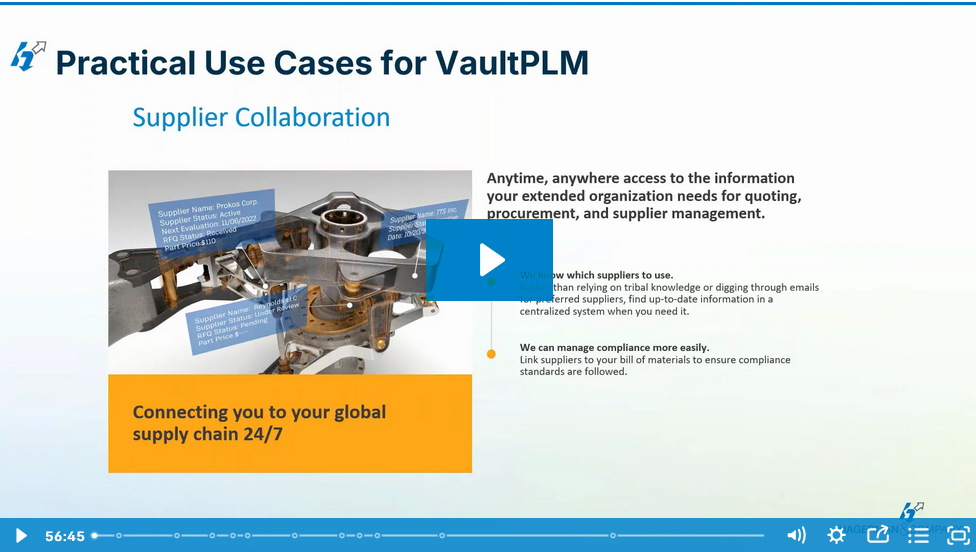In today’s fast-paced and competitive business environment, organizations are under more pressure than ever to deliver innovative products to market quickly, efficiently, and within budget. Bringing a product to market involves several moving parts, many different teams, and a lot of data. This is where Product Lifecycle Management (PLM) comes in.
This recorded webinar series introduces some of the most important functions of Product Lifecycle Management and shows you how Autodesk’s PLM tool, Autodesk Fusion Manage, can help your organization overcome traditional challenges of the product development lifecycle to get your products to market faster.
This series is an excellent introduction for organizations who are unfamiliar with, and just starting to explore, the concepts of Product Lifecycle Management before implementing it in their workflows.
Connected Data/Product Lifecycle Management Part 1: Introduction to Product Lifecycle Management
You’ve likely heard of Product Lifecycle Management, or PLM, but what does that really mean? PLM is more than just software; it’s a comprehensive approach to managing the entire lifecycle of a product from inception through design, manufacturing, service, and eventual disposal or retirement.
Part 1 of this webinar series takes you back to the basics, introducing PLM and its significance in an organization. You’ll learn the different PLM tools available to you and common challenges PLM can help you overcome and see a demonstration of PLM and Autodesk Fusion Manage in action.
Connected Data/Product Lifecycle Management Part 2: Bill of Materials
A Bill of Materials (BOM) is a comprehensive list of parts, items, assemblies, and other materials required to create a product - essentially a blueprint for a product’s physical and functional characteristics. But did you know there’s multiple types of BOMs? From Engineering and Manufacturing BOMs to Sales and Service BOMs, they are the foundation of product development, facilitate change management, and support sales and service after maintenance.
Part 2 of this webinar series dives into the creation, management, and importance of BOMs in PLM, outlines the different types of BOMs, and demonstrates how to integrate BOMs in other components of your workflow to increase efficiency.
Connected Data/Product Lifecycle Management Part 3: Engineering Change Orders
An Engineering Change Order (ECO) is a formal document used to implement changes to a product or process. ECOs are a crucial part of the product development workflow, documenting what was done, maintaining consistency in future developments, and facilitating communication and collaboration.
In Part 3 of this webinar series, you’ll learn the process and significance of Engineering Change Orders in PLM, understand common triggers for ECOs, and learn how to automate ECO processes in Autodesk Fusion Manage.
Connected Data/Product Lifecycle Management Part 4: Supplier Management
Effectively managing suppliers significantly influences product development and manufacturing. It helps overcome traditional challenges like navigating approvals, monitoring supplier performance, and moving beyond transactional interactions to improve supplier collaboration. Supplier management gives you better visibility into lead times, consistency in products and services, and helps you make informed decisions during the design phase.
Part 4 of this webinar series explores how PLM supports supply management and vendor collaboration. You’ll learn how to improve your supply chain efficiency to overcome the traditional challenges of supply management, and how to utilize the supply management features in Autodesk Fusion Manage.
Transform Your Workflows Today
Product Lifecycle Management might sound like a complex concept, but at its core it’s all about making the process of creating and managing products easier and more efficient. By helping businesses keep track of every stage of a product’s lifecycle, PLM ensures that products are developed, manufactured, and delivered with the highest level of quality, speed, and efficiency.
Whether you’re a small business just starting out, or a large company looking to transform your workflows, this webinar series will take you through the basics of PLM to help you make informed decisions and achieve your business goals. If you’re ready for PLM at your organization, reach out to the experts at Hagerman & Company to determine the best strategy for you.





Comments